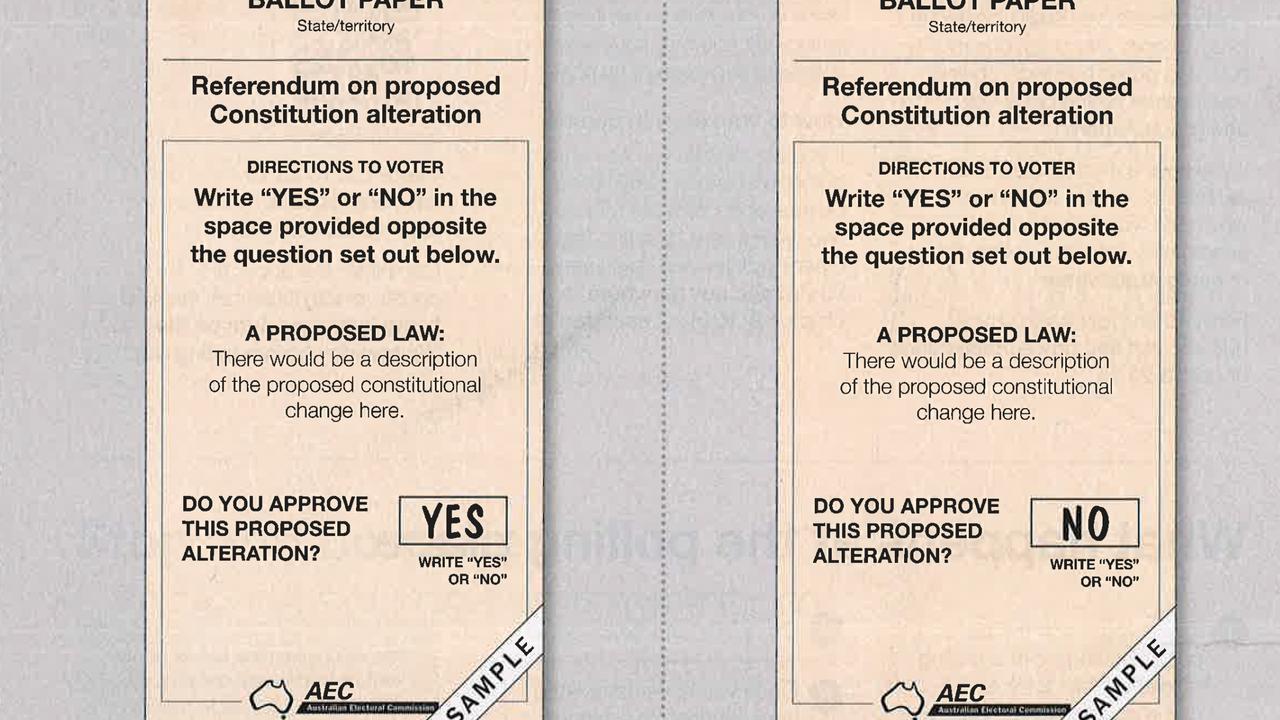Experts hit out at ‘petty and angry’ Voice ballot furore as specific rules to vote clarified
Experts and the electoral commission alike have lashed the No campaign – accusing them of brewing a “storm in a teacup” over ticks and crosses.
The Coalition have been lashed for sparking a fresh argument over the Voice referendum, with one expert labelling the latest furore around whether you can use a tick or cross to mark your vote “petty, angry and Machiavellian”.
In the upcoming referendum – the date of which will be announced next Wednesday – Australians will be told to write “yes” or “no” on a ballot paper asking if they support changing the constitution to include an Indigenous Voice to parliament.
A furore erupted after Australian Electoral Commissioner Tom Rogers hesitantly conceded that while longstanding “savings provisions” allowed a tick to be counted as a yes vote, a cross would be rendered an informal vote because of ambiguity.
Opposition Leader Peter Dutton has written to the AEC, calling the approach “fundamentally lopsided”, while associate professor Paul Williams said it would be “such a tiny number” of voters who did not clearly follow instructions.
The provision that allows a tick, a written “y” or “n” to be counted is part of the formality rules for referendum that have been the same since 1988. No changes to these rules were made when the Referendum Machinery Act went through parliament earlier this year.

Savings provisions exist in federal elections as well, and are a longstanding legislative requirement.
But Mr Dutton said the rule could “skew” the referendum “in favour of the Yes vote”, a similar argument to that made of monarchists in the lead up to the 1999 republic referendum.
During the last referendum, the AEC recorded just a 0.86 per cent informal vote, and said that many of those informal votes “would have had no relevance to the use of ticks or crosses”.
In comparison, in the 2022 federal election, informal voting for the Senate averaged 3.4 per cent across the country; with a 5.1 per cent average for the House of Representatives ballot.

Professor Williams said the opposition was employing “theatrics”, and was leaving “no stone unturned to maximise the No vote”.
He accused the No campaign, headed by the Coalition, of deliberately employing a scare tactic to “sew more seeds of confusion and doubt and contempt for process” - and unncessarily so, considering recent polling suggests support has slipped for a Yes vote.
“It is a bit of a storm in a teacup … it’s such a tiny number of voters who would tick or cross and not write on the form,” he said.
“We all know the referendum is going down anyways. This is one (fight) that the opposition probably should have let go through to the keeper, because it looks petty, it looks angry, it looks vindictive, it looks Machiavellian, and it’s stretching the bounds of credulity.”
He said there was a much lower rate of informal voting in referendums compared to federal elections because the question, and rules, were so clear.
Australian Labor Party president Wayne Swan accused the No campaign of using the electoral system to “try to discredit the Voice”.
“And in doing so, doing what so many other right wing parties around the world are doing, discrediting basic electoral arrangements,” he told Channel 9.
“It is appalling. I am disgusted by their behaviour.”
In a letter to the AEC, Mr Dutton and shadow attorney-general Michaelia Cash wrote that “counting a tick as a formal vote while simultaneously excluding a cross as informal could artificially skew the count towards the yes vote, and fail to accurately reflect the will of the Australian people”.
“Just because the AEC has adopted this approach before, does not mean that it is appropriate or legally correct … We call on you to consider the approach. If a tick counts for yes, a cross should count for no.”
In a statement, the AEC said they “completely and utterly reject” the suggestions that “by transparently following the established, public and known legislative requirements, we are undermining the impartiality and fairness of the referendum”.
“The law regarding savings provisions and the principle around a voter’s intent has been in place for at least 30 years and 6 referendum questions,” they said.
The AEC clearly stipulates that voters should only use “yes” or “no” as answers on the ballot, warning that writing anything else would “become a judgement call as to the voter’s intent”.
“The formal voting instructions … are to clearly write either ‘yes’ or ‘no’, in full, in English. It is that easy: given the simplicity, the AEC expects the vast, vast majority of Australian voters to follow those instructions and cast a formal vote.”

The AEC said that since 1988 – and including the last two referendums – they had followed legal advice regarding the application of savings provisions to ‘ticks’ and ‘crosses’ on referendum ballot papers
“This is not new,” the AEC said.
“The longstanding legal advice provides that a cross can be open to interpretation as to whether it denotes approval or disapproval: many people use it daily to indicate approval in checkboxes on forms. The legal advice provides that for a single referendum question, a clear ‘tick’ should be counted as formal and a ‘cross’ should not.”



